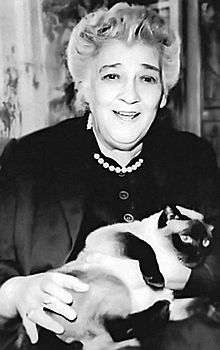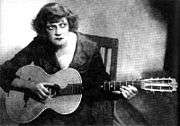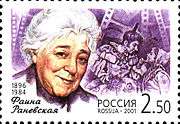Faina Ranevskaya

Faina Georgievna Ranevskaya (Russian: Фаина Георгиевна Раневская, born Faina Girschevna Feldman, 27 August [O.S. 15 August] 1896 - 19 July 1984) is recognized as one of the greatest Soviet actresses in both tragedy and comedy. She was also famous for her aphorisms.[1]
She acted in plays by Anton Chekhov, Aleksandr Ostrovsky, Maxim Gorky, Ivan Krylov, Fyodor Dostoevsky, Leo Tolstoy, and others. Unfortunately, our judgement of her theater performances must come mostly from photos as only her three final performances of Make Way for Tomorrow by Vina Delmar, Truth is Good, but Happiness is Better by Aleksandr Ostrovsky, The Curious Savage by John Patrick were filmed. Faina Ranevskaya is more known to a wide audience as a cinema actress by her performance in such films as Pyshka (Boule de Suif), The Man in a Shell, Mechta (Dream), Vesna (Spring), Cinderella, Elephant and String and many more.
Biography

She was born as Faina Feldman (Фельдман) to a wealthy Jewish family in the city of Taganrog. Her father, Girsch Haimovich Feldman, owned a dry-ink factory, several buildings, a shop and the steamboat "Saint Nicolas". He was the head of Taganrog synagogue and a founder of a Jewish asylum for the aged. Faina's mother, Milka Rafailovna (née Zagovaylova), was a great admirer of literature and art. That and her passion for Chekhov influenced Faina's love of art, poetry, music, and theater. There were three other children in the family - two brothers and an older sister named Bella.
Faina Feldman attended the elementary school classes at the Mariinskaya Gymnasium for Girls, and then received regular home education. She was given music, singing, foreign languages lessons. Faina loved reading.

Her passion for theater began when she was 14. Her attendance of Chekhov's The Cherry Orchard at the Moscow Art Theater was an experience that had great impact on her. Her pseudonym "Ranevskaya," which later became her official surname, also came from that theater visit.
In 1915 she left Taganrog for Moscow to pursue a career in the theater. Faina became estranged from her family over her choice of career, which they apparently rejected. She started as an extra actor in crowd or background scenes at the Summer Theater in Malakhovka near Moscow in 1915, where she also had a dacha.
The Feldman family emigrated in 1917, but Faina decided to stay and continued her acting career, working in the theaters of Kerch, Rostov on Don, at the mobile theater "The First Soviet Theater" in Crimea, also in Baku, Arkhangelsk, Smolensk and other cities.
In 1931 Ranevskaya acted at the Chamber Theater.
The film Pyshka (known as Boule de Suif in the U.S.), directed by Mikhail Romm, marked her debut as a film actress in 1934. It was a silent black and white film based on the novel Boule de Suif by Guy de Maupassant, in which she starred as Madame Loiseau. Although the film was silent, Ranevskaya learned several sayings of Madame Loiseau in French from the original novel by Maupassant. Romain Rolland, a French writer who visited the Soviet Union in the 1930s, loved the film, and his favorite actor in the movie was Faina Ranevskaya.

At his request, the Pyshka (Boule de Suif) was shown in French cinemas, where it became a box-office success. Ranevskaya played on stage of the Central Academic Theatre of the Russian Army (1935-1939), Drama Theater, now Mayakovsky Theater (1943-1949), Moscow Pushkin Drama Theatre (1955-1963), and finally Mossovet Theater (1949-1955, 1963-1983), where she worked with Yury Zavadsky.
The actress was awarded the Stalin Prize for outstanding creative achievements on stage in 1949, and in 1951 for her work in the film U nih est' Rodina (They Have Their Motherland), directed by Vladimir Legoshin and Alexandre Feinzimmer. In 1961 Faina Ranevskaya was awarded the title of People's Artist of the USSR.
The actress died in 1984 in Moscow and was buried at the Donskoe Cemetery. A memorial plate dedicated to Ranevskaya was placed on her birthhouse in the city of Taganrog on August 29, 1986.
In 1992 British "Who's Who" encyclopedia named Ranevskaya among the world's Top Ten Actors of the 20th century. That was done despite the fact that the actress had never played a major part in a movie: all her roles were supporting ones.[2] In a newspaper article, one of the Soviet movie industry apparatchiks explained her lack of main roles by Faina Ranevskaya's "typical Semitic" face features.[3]
On May 16, 2008, the Ranevskaya Monument was inaugurated in Taganrog in front of actress's birth house on Ulitsa Frunze 10 within the framework of the International Ranevskaya Theater Festival "The Great Province".
Filmography
- 1934 - Pyshka (Пышка, Boule de Suif)
- 1938 - Duma Pro Kozaka Holotu (Дума про казака Голоту, The Tale of Cossack Holota)
- 1939 - Chelovek V Futlyare (Человек в футляре, The Man in a Shell)
- 1939 - Oshibka Inzhenyera Kochina (Ошибка инженера Кочина, The Mistake of the Engineer Kochin)
- 1939 - Podkidysh (Подкидыш, The Foundling)
- 1941 - Mechta (Мечта, The Dream)
- 1943 - Novye Pokhozhdeniya Shveyka (Новые похождения Швейка, The New Adventures of Schweik)
- 1944 - Svadba (Свадьба, The Wedding)
- 1945 - Nebesnyy Tikhokhod (Небесный тихоход, Celestial Slow-Walker)
- 1947 - Ryadovoy Aleksandr Matrosov (Рядовой Александр Матросов, Private Alexandr Matrosov)
- 1947 - Vesna (Весна, Spring) - see Lyubov Orlova, Nikolai Cherkasov
- 1947 - Zolushka (Золушка, Cinderella)
- 1949 - Vstrecha Na Elbe (Встреча на Эльбе, Meeting on the Elba)
- 1958 - Devushka S Gitaroy (Девушка с гитарой, The Girl With Guitar)
- 1960 - Ostorozhno, Babushka! (Осторожно, бабушка, Watch Out, Grandma!)
- 1964 - Lyogkaya Zhizn (Лёгкая жизнь, Easy Life)
- 1965 - Sevodnya - Novyy Attraktsion (Сегодня - новый аттракцион, Today - New Side Show)
Ranevskaya's aphorisms
- Life is a short promenade, just before the eternal sleep.
- Solitude is a house that has a telephone, but the only ringing comes from the alarm-clock.
- Life is a sky-dive: out of a cunt, into the grave.
- Ageing is tedious, but it is the only way to live long.
- I spent all my life swimming in a toilet-bowl, in the butterfly style.
- There are people with God inside, there are people with the devil inside and there are people with only parasites inside!
References
External links
- Faina Ranevskaya at the Internet Movie Database
- (English) Monument to Ranevskaya Inaugurated in Taganrog
- (English) First International Ranevskaya Drama Festival "The Great Province"
- (English) Website about Faina Ranevskaya